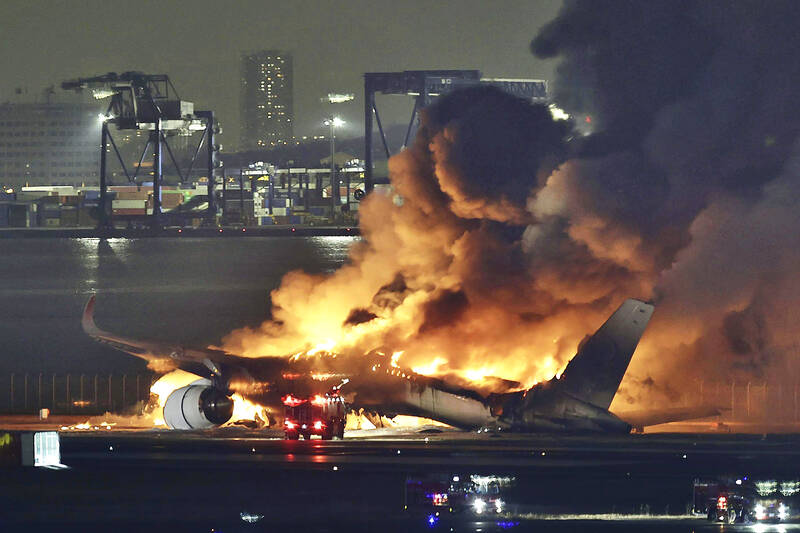From the moment a Japan Airlines (JAL) passenger jet collided with a smaller plane on a runway in Tokyo on Jan. 2, it took crew 18 mins to get all 367 travelers off the plane and safely accounted for.
Reconstructing the scene based on crew accounts, officials at Japan’s second biggest airline on Jan. 3 said crew followed emergency procedures in textbook fashion, starting with the first rule: panic control.
As soon as the Airbus A350 wide-body jet came to a stop, cabin attendants called out to passengers to remain calm as bright-orange flames engulfed large areas of the plane and smoke quickly filled the cabin.

Photo: Reuters 照片:路透
The crew quickly sized up the situation with visual checks of the exterior and decided which of the eight emergency exits were safe for use. They then used short, direct commands, as they are trained to do, such as “leave your luggage” and “not this door,” officials said.
Some passengers interviewed at the airport late on Jan. 2 credited the swift evacuation drill with saving their lives.
EVACUATION CHUTES

Photo: AP 照片:美聯社
Emergency protocol stipulates that crew must have permission from the cockpit to open any emergency exits. The captain stood near the two exits up front and gave the go-ahead for evacuation.
But the third safe exit in the rear could not be cleared because the public announcement and intercom systems were no longer functioning. The cabin crew then made the correct decision to open the door anyway, allowing passengers to slide down the evacuation chutes, JAL said.
All cabin attendants get trained once a year on evacuation procedures, simulating various scenarios such as what to do when they cannot communicate with the cockpit, officials said.

Photo: AP 照片:美聯社
After ensuring that all passengers had slid safely down the three slides, the crew and pilots completed the evacuation at 6:05 PM (0905 GMT), or 18 mins after landing.
90 SECONDS
Modern planes must be able to fully evacuate in as little as 90 seconds, using just half the number of their available exits. The JAL occupants managed with even fewer. One flight attendant quickly decided to open an emergency door toward the back of the jet to help more people escape via the emergency slides, government officials said at a press conference the day after the disaster.
Aircraft manufacturers train rapid evacuations in order to gain certification, and the 90-second rule has existed for decades after regulators determined modern aircraft can structurally withstand a blast for at least that long. Even the giant Airbus A380, with the additional complication of two full-length flight decks, has managed to empty out with a few seconds to spare.
The crash is the first significant accident involving the Airbus A350, Europe’s premier long-haul jet, in service since 2015. It is also the first time a passenger plane built mainly from lightweight carbon composites has burned totally.
The A350-900 was certified for a full load of up to 440 passengers to be evacuated within 90 seconds with only half of the exits usable.
“The JAL cabin crew should be highly commended for their textbook evacuation,” an Airbus spokesperson said. JAL officials said the crew on flight 516, from near the northern Japanese city of Sapporo to Tokyo’s Haneda airport, had followed appropriate procedures, but also praised the passengers for the orderly exit from a full flight that included eight pre-school children.
Aviation safety agencies have warned for years that pausing to collect carry-on baggage risks lives during an evacuation.
(Reuters and Bloomberg)
1月2日,日本航空一架客機在東京跑道上與一架較小的飛機相撞,18分鐘後,機組人員成功將367名乘客全部安全撤出。
身為日本第二大航空公司的日航,其官員1月3日根據機組人員的描述重建現場,表示機組人員以教科書等級的方式遵循緊急程序,由第一條規則開始:控制恐慌。
這架空中巴士A350廣體客機一停下,空服員就呼籲乘客保持冷靜,因為飛機的一大部分已被亮橙色火焰吞噬,機艙很快就煙霧瀰漫。
機組人員以目測檢查機體外部,迅速評估了狀況,並決定八個緊急出口中哪些可以安全使用。官員表示,然後他們按照訓練的方式使用簡短、直接的命令,例如「留下你的行李」和「不要用這個門」。
1月2日晚間在機場接受採訪的一些乘客認為,迅速疏散的演習救了他們的命。
疏散滑梯
緊急應變措施規定,機組人員必須獲得駕駛艙的准許才能打開任何緊急出口。機長要站在前面兩個出口附近,批准撤離。
但由於機上廣播及對講系統故障,後方的第三個安全出口無法通行。日航表示,機組人員隨後做了正確的決定,無論如何都打開艙門,讓乘客滑下疏散滑梯。
官員表示,所有空服員每年都會接受一次疏散程序的培訓,模擬各種場景,例如當他們無法與駕駛艙溝通時該如何應變。
在確保所有乘客自三個滑梯安全滑下後,機組人員與機師於下午6點05分(格林威治標準時間早上9點05分)完成疏散,即著飛機陸後18分鐘。
90秒時間
現代飛機必須能夠在短短90秒內將人員完全撤離,僅使用可用出口數量的一半,日航所用的甚至更少。政府官員在事發第二天所舉行的記者會中表示,一名空服員迅速決定打開飛機後部的緊急逃生門,以幫助更多人用緊急滑梯逃生。
飛機製造商為獲取認證而訓練快速疏散,在監管機構確定現代飛機在結構上能夠承受至少90秒長的爆炸後,90秒規則已存在了數十年。即便是巨大的空中巴士A380型飛機,加上兩個全長駕駛艙的額外複雜性,也能在數秒內淨空。
這起碰撞是空中巴士A350首起重大事故,空中巴士A350是歐洲首屈一指的長途噴射機,自2015年起開始投入載運。這也是第一起主要以輕質碳複合材料製造之客機完全燃燒的事故。
A350-900經認證,可在90秒內疏散滿載時最多的440名乘客,而只用半數的逃生出口。
空中巴士發言人表示:「日航機組人員教科書等級的疏散行動,應該受到高度讚揚」。日航官員表示,由日本北部城市札幌附近飛往東京羽田機場的516號班機之機組人員遵循了適當的程序,也稱讚包括8名學齡前兒童在內的乘客,有序地從機上撤離。
飛航安全機構多年來一直警告說,在疏散過程中暫停下來拿隨身行李可能會危及生命。
(台北時報林俐凱編譯)

In an effort to fight phone scams, British mobile phone company O2 has introduced Daisy, an AI designed to engage phone con artists in time-wasting conversations. Daisy is portrayed as a kindly British granny, exploiting scammers’ tendency to target the elderly. Her voice, based on a real grandmother’s for authenticity, adds to her credibility in the role. “O2” has distributed several dedicated phone numbers online to direct scammers to Daisy instead of actual customers. When Daisy receives a call, she translates the scammers’ spoken words into text and then responds to them accordingly through a text-to-speech system. Remarkably, Daisy

Bilingual Story is a fictionalized account. 雙語故事部分內容純屬虛構。 Emma had reviewed 41 resumes that morning. While the ATS screened out 288 unqualified, she screened for AI slop. She could spot it a mile away. She muttered AI buzzwords like curses under her breath. “Team player.” “Results-driven.” “Stakeholder alignment.” “Leveraging core competencies.” Each resume reeked of AI modeling: a cemetery of cliches, tombstones of personality. AI wasn’t just changing hiring. It was draining the humanity from it. Then she found it: a plain PDF cover letter. No template. No design flourishes. The first line read: “I once tried to automate my

Every May 1, Hawaii comes alive with Lei Day, a festival celebrating the rich culture and spirit of the islands. Initiated in 1927 by the poet Don Blanding, Lei Day began as a tribute to the Hawaiian custom of making and wearing leis. The idea was quickly adopted and officially recognized as a holiday in 1929, and leis have since become a symbol of local pride and cultural preservation. In Hawaiian culture, leis are more than decorative garlands made from flowers, shells or feathers. For Hawaiians, giving a lei is as natural as saying “aloha.” It shows love and

1. 他走出門,左右看一下,就過了馬路。 ˇ He walked outside, looked left and right, and crossed the road. χ He walked outside and looked left and right, crossed the road. 註︰並列連接詞 and 在這句中連接三個述語。一般的結構是 x, y, and z。x and y and z 是加強語氣的結構,x and y, z 則不可以。 2. 他們知道自己的弱點以及如何趕上其他競爭者。 ˇ They saw where their weak points lay and how they could catch up with the other competitors. χ They saw where their weak points lay and how to catch up with the other competitors. 註:and 一般連接同等成分,結構相等的單詞、片語或子句。誤句中 and 的前面是子句,後面是不定詞片語,不能用 and 連接,必須把不定詞片語改為子句,and 前後的結構才相等。 3. 她坐上計程車,直接到機場。 ˇ She took a cab, which took her straight to the airport. ˇ She took a cab and it took her straight